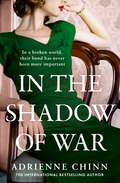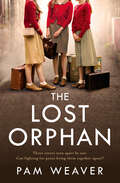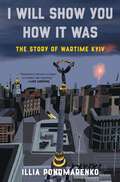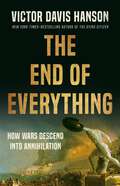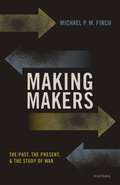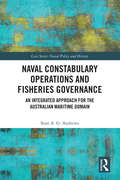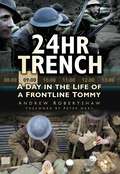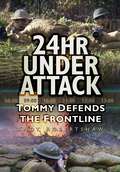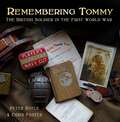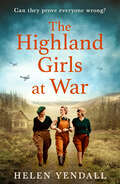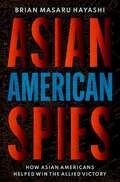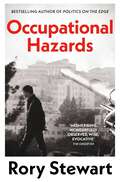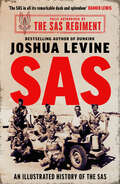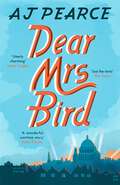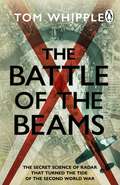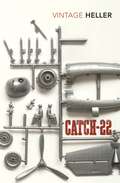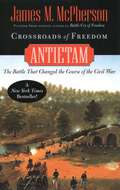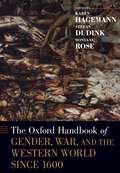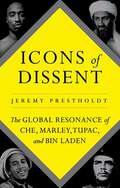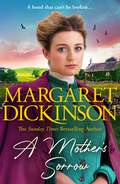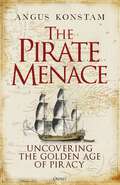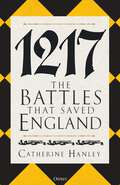- Table View
- List View
In the Shadow of War (The Three Fry Sisters #3)
by null Adrienne Chinn‘An emotive and engaging read’ Bestselling author Rosanna Ley One war may be over, but their fight for survival continues… For sisters Etta, Jessie and Celie Fry, the Great War and the hardships of the years that followed have taken a heavy toll. Determined to leave her painful past behind her, Etta heads to the bright lights of Hollywood whilst Jessie, determined to train as a doctor and use her skills to help others, is hampered by the men who dominate her profession. On the vast, empty plains of the Canadian prairies, Celie and her small family stand on the brink of losing everything. As whispers of a new war make their way to each sister, each must face the possibility of the unthinkable happening again… Praise for Adrienne Chinn: 'Rich, evocative and utterly immersive, this beautifully written book swept me away' Jenny Ashcroft, author of Meet Me in Bombay 'It is one of those books that you can't put down but also don't want to finish too soon!’ ⭐⭐⭐⭐⭐ 'An excellent read which once started was impossible to put down. I’m so hoping for book 4! Highly recommend this series’ ⭐⭐⭐⭐⭐ 'Brilliant storytelling. Highly recommended. I can't wait for the next one.' ⭐⭐⭐⭐⭐ 'Fabulous characters and storylines which bring in aspects of real history. Superb storytelling.’ ⭐⭐⭐⭐⭐ 'An excellent read which, once started, was impossible to put down. Highly recommend this series.’ ⭐⭐⭐⭐⭐ 'A fantastic book which kept me enthralled all the way through.’ ⭐⭐⭐⭐⭐
The Lost Orphan
by null Pam WeaverThree sisters torn apart by war. Can fighting for peace bring them together again? December 1941: Evacuated from the threat of German bombs, sisters Amelie and Mireille have grown up under the storm clouds of war. Now they have joined the fight against Hitler, with Amelie training as a nurse to save wounded soldiers, and Mireille enlisted to help the Air Force wage war in the skies over Europe. But as each sister fights for peace, they are still haunted by the memory of their missing sister who was snatched away from them at the beginning of the war. As Mireille is recruited for a special forces role behind enemy lines in France, she puts her life on the line for the Allies. But could she also finally have a chance of reuniting her sisters, once the war is over? A heart-breaking tale of the bond between sisters and the courage of women in wartime. Perfect for fans of Shirley Dickson, Glynis Peters and Pam Jenoff. Readers adore The Lost Orphan: ‘I quite literally could not put it down! My heart was in my mouth, both with Mireille in France, and Amelie and her vile partner back home. I was so caught up in all the emotion and sobbed at the end.’ Reader Review ⭐⭐⭐⭐⭐ ‘I enjoyed The Lost Orphan and read it in a day! The characters are brave sisters with a troubled past who are doing their 'bit' in the British war effort. The author has a wonderful sense of plot and place and the story moves right along.’ Reader Review ⭐⭐⭐⭐⭐ ‘An emotional rollercoaster … Great characters and pacy storylines make this a compelling read.’ Reader Review ⭐⭐⭐⭐⭐ ‘The sisters have amazing personalities with their strength and determination shining through. As I read of their encounters they felt like old friends who I couldn’t wait to meet with again. This has been an absolutely brilliant novel that I was unable to put down and when I reached the last page I had tears in my eyes.’ Reader Review ⭐⭐⭐⭐⭐ ‘Full of twists and turns … Now I have a book hangover and don't know what to follow this with!’ Reader Review ⭐⭐⭐⭐⭐ ‘It is heartbreaking and heartwarming at the same time. The characters are so real, I felt as if I knew them and would have felt right at home stepping into Jim and Norah’s kitchen. Pam Weaver is a great storyteller.’ Reader Review ⭐⭐⭐⭐⭐
I Will Show You How It Was: The Story of Wartime Kyiv
by Illia Ponomarenko"A story of searing clarity from Ukraine's frontlines of an unfathomably resilient, freedom loving people who refuse to bend to Putin's assault on truth and human life."-Nicole Perlroth“Destined to become a classic of modern war reporting.”-Luke HardingA raw, irreverent account of a young Ukrainian reporter on-the-ground as his country heroically defends itself against the Russian invasion. In late February 2022, a series of missiles and rocket strikes began falling upon Ukraine, as the Russian military barreled over the border and fanned out across the country. First they took Chernobyl, then Kherson, then Mariupol. Time stood still as the world waited for Ukraine to flatten underneath the boot of its neighbor. Meanwhile, on the front lines in the capital city, Kyiv Independent reporter Illia Ponomarenko was seeing a different story on unfold: after months-years-of waiting for this long-feared attack, Ukraine was fed up and ready to fight back. The Russians bogged down hard in combat east and west of Kyiv. They got exhausted. They screwed up logistics. They sustained heavy losses. Their unbelievably overconfident blitz was failing. I Will Show You How It Was is Illia Ponomarenko's heart-wrenching memoir of the war on his homeland, offering a fiery diatribe against Russian hypocrisy and a moving look at what is being lost. But it's also a story of pride and even elation as Ukrainian forces come together, find their mojo, and oust the invaders from Kyiv. The most powerful and personal chronicle of the war to date, I Will Show You How It Was is an exceptional literary achievement, chronicling a stunning feat of resistance and a courageous people set on a miraculous victory.
The End of Everything: How Wars Descend into Annihilation
by Victor Davis HansonIn this &“gripping account of catastrophic defeat&” (Barry Strauss), a New York Times–bestselling historian charts how and why some societies chose to utterly destroy their foes, and warns that similar wars of obliteration are possible in our time &“In The End of Everything, Hanson tells compelling and harrowing stories of how civilizations perished. He helps us consider contemporary affairs in light of that history, think about the unthinkable, and recognize the urgency of trying to prevent our own demise.&” — H. R. McMaster, author of Battlegrounds War can settle disputes, topple tyrants, and bend the trajectory of civilization—sometimes to the breaking point. From Troy to Hiroshima, moments when war has ended in utter annihilation have reverberated through the centuries, signaling the end of political systems, cultures, and epochs. Though much has changed over the millennia, human nature remains the same. Modern societies are not immune from the horror of a war of extinction. In The End of Everything, military historian Victor Davis Hanson narrates a series of sieges and sackings that span the age of antiquity to the conquest of the New World to show how societies descend into barbarism and obliteration. In the stories of Thebes, Carthage, Constantinople, and Tenochtitlan, he depicts war&’s drama, violence, and folly. Highlighting the naivete that plagued the vanquished and the wrath that justified mass slaughter, Hanson delivers a sobering call to contemporary readers to heed the lessons of obliteration lest we blunder into catastrophe once again.
Making Makers: The Past, the Present, and the Study of War
by Michael P. FinchMaking Makers presents a comprehensive history of a seminal work of scholarship which has exerted a persistent attraction for scholars of war and strategy: Makers of Modern Strategy. It reveals the processes by which scholars conceived and devised the book, considering both successful and failed attempts to make and remake the work across the twentieth century, and illuminating its impact and legacy. It explains how and why these influential volumes took their particular forms, unearths the broader intellectual processes that shaped them, and reflects on the academic parameters of the study of war in the twentieth century. In presenting a complete genesis of the Makers project in the context of intellectual trends and historical contingency, this book reflects on a more complex and nuanced appraisal of the development of scholarship on war. In so doing it also offers contributions to the intellectual biographies of key figures in the history of war in the twentieth century, such as Edward Mead Earle, Peter Paret, Gordon Craig, and Theodore Ropp. Making Makers contributes to an intellectual history of military history and contextualises the place of history and historians in strategic and security studies. It is not only a history of the book, but a history of the networks of scholars involved in its creation, their careers, and lines of patronage, crossing international boundaries, from Europe to the USA, to Asia and Australia. It is an investigation of ideas, individuals, and groups, of work completed and scholarship produced, as well as contingency and opportunities missed.
Naval Constabulary Operations and Fisheries Governance: An Integrated Approach for the Australian Maritime Domain (ISSN)
by Sean A. AndrewsThis book offers an analysis of naval constabulary operations, in particular Australian fisheries patrols, and challenges the widely accepted Anglo-American school of maritime thought.In the Indo-Pacific, fisheries and the activities of fishing boats are of increasing strategic importance in Australia’s region – Australia’s Four Oceans. Issues of overfishing, population growth and climate change are placing growing pressure on fish as a resource, and in doing so are making fisheries more significant, and significant on a strategic as opposed to simply an economic or environmental level. When, combined with the growing use of fishing vessels as para-naval forces, it is clear that the activities of fishing vessels, whether fishing or not fishing, are matters of considerable strategic relevance. This book illuminates contemporary seapower challenges, explains and defines maritime security and examines and refines existing theory to advance a set of new or refined concepts to help frame the on-water activities of constabulary operations -- reducing the possibility of on-water miscalculation between states.This book will be of much interest to students and scholars of naval studies and sea power, maritime strategy, maritime security and International Relations.
Naval Constabulary Operations and Fisheries Governance: An Integrated Approach for the Australian Maritime Domain (ISSN)
by Sean A. AndrewsThis book offers an analysis of naval constabulary operations, in particular Australian fisheries patrols, and challenges the widely accepted Anglo-American school of maritime thought.In the Indo-Pacific, fisheries and the activities of fishing boats are of increasing strategic importance in Australia’s region – Australia’s Four Oceans. Issues of overfishing, population growth and climate change are placing growing pressure on fish as a resource, and in doing so are making fisheries more significant, and significant on a strategic as opposed to simply an economic or environmental level. When, combined with the growing use of fishing vessels as para-naval forces, it is clear that the activities of fishing vessels, whether fishing or not fishing, are matters of considerable strategic relevance. This book illuminates contemporary seapower challenges, explains and defines maritime security and examines and refines existing theory to advance a set of new or refined concepts to help frame the on-water activities of constabulary operations -- reducing the possibility of on-water miscalculation between states.This book will be of much interest to students and scholars of naval studies and sea power, maritime strategy, maritime security and International Relations.
24hr Trench: A Day in the Life of a Frontline Tommy
by Andrew RobertshawThe trench was the frontline Tommy’s home. He lived, ate, slept, and sometimes died in this narrow passage amongst the slime of mud and blood on the Western Front. His washbasin was a mess-tin, his cooker – a small fire built into the wall, his entertainment – his friends, his fear – the man living in the trench on the other side of No Man’s Land. Over 6 million men died whilst serving in the trenches – how did they live in them? For the first time, World War I historian Andrew Robertshaw and a group of soldiers, archaeologists and historians use official manuals and diaries to build a real trench system and live in it for 24 hours, recreating the frontline Tommy’s daily existence, answering the questions: How do you build a trench quietly? How clean can you really get in a trench? How easy is it to sleep? How do you keep yourself entertained? How to do you stay alive and kill the enemy? And many more… Hour-by-hour, the Tommy’s day unfolds through stunning colour photographs in this ground-breaking experiment in Great War history.
24hr Under Attack: Tommy Defends the Frontline
by Andrew RobertshawTen million military personnel died during the Great War. Many millions of them experienced horrendous enemy attacks on entrenched positions that stretched across France and Belgium, as well as further afield. This groundbreaking book relives twenty-four hours of an actual Platoon under attack, using a battalion war diary to follow the assault hour by hour. A team of historians and archaeologists reconstructs the fighting, revealing how the British Tommy defended his hard-won positions against heavy fire and enemy attack. Robertshaw presents the Great War in colour, as it was experienced, using stunning images to bring the the full force of these frightening assaults to life. This truly is First World War history at its finest.
Remembering Tommy: The British Soldier in the First World War
by Peter Doyle Chris FosterThe British soldier of the Great War has been depicted in many books. Invariably, a pen picture paints him as stoic, joining the army in a wave of patriotic fervour, and destined to serve four years on the Western Front in some of the most costly battles in history. Yet often the picture is difficult to resolve for the reader. What was it like in the trenches? How did the soldier live, where did he sleep? What was it like to go over the top, and when he did, what did he carry with him? For many, the idea of trench life is hazy, and usually involves ‘drowning in mud’, in, as one writer put it, ‘the pitiless misery’ of Passchendaele. Recently, military historians have presented an alternative picture, a picture in which the hopelessness of the First World War is given new life and purpose. Remembering Tommy pays tribute to the real life British soldier of the Great War from the moment of joining up to their final homecoming. Using original artefacts in historic settings, the men and their words are brought to life. The uniforms they wore, the equipment they carried, the letters they wrote home, their personal possessions, mementos and photographs come together in a powerful tribute to the indomitable Tommy. Each one of these precious artefacts bears witness to the men who left them behind – allowing us to almost reach out and touch history.
The Highland Girls at War (The Highland Girls series #1)
by null Helen YendallCan the Highland girls prove everyone wrong? Don’t miss this poignant and heartwarming WW2 novel for fans of Rosie Clarke, Dilly Court and Rosie Archer, from the author of A Wartime Secret. Scotland, 1942.The Lumberjills, the newest recruits in the Women’s Timber Corps, arrive in the Scottish Highlands to a hostile reception from doubtful locals. The young women are determined to prove them wrong and serve their country – but they’re also all looking for something more… Lady Persephone signed up to show everyone she’s more than just a pretty face – but it’ll take more than some charm and her noble credentials to win handsome Sergeant Fraser over. Tall, strong Grace has led a lonely life working on a croft, with just her mother for company. All she wants is to find her place in the world – even if that’s a thousand miles from home. And Irene misses her husband terribly, so until he returns home from the frontline, she’s distracting herself with war work. But one distraction too far leads to devastating consequences… Can the Lumberjills get through their struggles together – even when tragedy strikes? Readers LOVE The Highland Girls at War! ‘I adored it!!… From start to finish, I loved it and couldn’t wait to get back to it whenever I had to rip myself away… It certainly left me wanting more! It was brilliant.’ NetGalley reviewer, ⭐⭐⭐⭐⭐ ‘Love this book… The characters came to life as the story unrolled and I was sad the book ended as I felt I knew them and they were my friends too. Recommended to read ASAP.’ NetGalley reviewer, ⭐⭐⭐⭐⭐ ‘Absolutely loved [it], great book from start to finish.’ NetGalley reviewer, ⭐⭐⭐⭐⭐ ‘Loved this book from start to finish, the characters were so real and I felt like a member of the family.’ NetGalley reviewer, ⭐⭐⭐⭐⭐ ‘A compelling, heartwarming tale… Full of laughter, heartache, humour and wistful romance… A story of sisterhood and one I am certain will stay with me forever.’ NetGalley reviewer, ⭐⭐⭐⭐⭐ ‘A heart-warming story… Thoroughly enjoyable.’ NetGalley reviewer, ⭐⭐⭐⭐⭐
Asian American Spies: How Asian Americans Helped Win the Allied Victory
by Brian Masaru HayashiA recovery of the vital role Chinese, Japanese, and Korean Americans played in US intelligence services in Asia during World War II. Spies deep behind enemy lines; double agents; a Chinese American James Bond; black propaganda radio broadcasters; guerrilla fighters; pirates; smugglers; prostitutes and dancers as spies; and Asian Americans collaborating with Axis Powers. All these colorful individuals form the story of Asian Americans in the Office of Strategic Services (OSS), the forerunner of today's CIA. Brian Masaru Hayashi brings to light for the first time the role played by Chinese, Japanese, and Korean Americans in America's first centralized intelligence agency in its fight against the Imperial Japanese forces in east Asia during World War II. They served deep behind enemy lines gathering intelligence for American and Chinese troops locked in a desperate struggle against Imperial Japanese forces on the Asian continent. Other Asian Americans produced and disseminated statements by bogus peace groups inside the Japanese empire to weaken the fighting resolve of the Japanese. Still others served with guerrilla forces attacking enemy supply and communication lines behind enemy lines. Engaged in this deadly conflict, these Asian Americans agents encountered pirates, smugglers, prostitutes, and dancers serving as the enemy's spies, all the while being subverted from within the OSS by a double agent and without by co-ethnic collaborators in wartime Shanghai. Drawing on recently declassified documents, Asian American Spies challenges the romanticized and stereotyped image of these Chinese, Japanese, and Korean American agents--the Model Minority-while offering a fresh perspective on the Allied victory in the Pacific Theater of World War II.
Making Makers: The Past, the Present, and the Study of War
by Michael P. FinchMaking Makers presents a comprehensive history of a seminal work of scholarship which has exerted a persistent attraction for scholars of war and strategy: Makers of Modern Strategy. It reveals the processes by which scholars conceived and devised the book, considering both successful and failed attempts to make and remake the work across the twentieth century, and illuminating its impact and legacy. It explains how and why these influential volumes took their particular forms, unearths the broader intellectual processes that shaped them, and reflects on the academic parameters of the study of war in the twentieth century. In presenting a complete genesis of the Makers project in the context of intellectual trends and historical contingency, this book reflects on a more complex and nuanced appraisal of the development of scholarship on war. In so doing it also offers contributions to the intellectual biographies of key figures in the history of war in the twentieth century, such as Edward Mead Earle, Peter Paret, Gordon Craig, and Theodore Ropp. Making Makers contributes to an intellectual history of military history and contextualises the place of history and historians in strategic and security studies. It is not only a history of the book, but a history of the networks of scholars involved in its creation, their careers, and lines of patronage, crossing international boundaries, from Europe to the USA, to Asia and Australia. It is an investigation of ideas, individuals, and groups, of work completed and scholarship produced, as well as contingency and opportunities missed.
Asian American Spies: How Asian Americans Helped Win the Allied Victory
by Brian Masaru HayashiA recovery of the vital role Chinese, Japanese, and Korean Americans played in US intelligence services in Asia during World War II. Spies deep behind enemy lines; double agents; a Chinese American James Bond; black propaganda radio broadcasters; guerrilla fighters; pirates; smugglers; prostitutes and dancers as spies; and Asian Americans collaborating with Axis Powers. All these colorful individuals form the story of Asian Americans in the Office of Strategic Services (OSS), the forerunner of today's CIA. Brian Masaru Hayashi brings to light for the first time the role played by Chinese, Japanese, and Korean Americans in America's first centralized intelligence agency in its fight against the Imperial Japanese forces in east Asia during World War II. They served deep behind enemy lines gathering intelligence for American and Chinese troops locked in a desperate struggle against Imperial Japanese forces on the Asian continent. Other Asian Americans produced and disseminated statements by bogus peace groups inside the Japanese empire to weaken the fighting resolve of the Japanese. Still others served with guerrilla forces attacking enemy supply and communication lines behind enemy lines. Engaged in this deadly conflict, these Asian Americans agents encountered pirates, smugglers, prostitutes, and dancers serving as the enemy's spies, all the while being subverted from within the OSS by a double agent and without by co-ethnic collaborators in wartime Shanghai. Drawing on recently declassified documents, Asian American Spies challenges the romanticized and stereotyped image of these Chinese, Japanese, and Korean American agents--the Model Minority-while offering a fresh perspective on the Allied victory in the Pacific Theater of World War II.
Occupational Hazards: My Time Governing In Iraq
by Rory StewartA fascinating insight into the complexity, history and unpredictability of Iraq from Rory Stewart, bestselling author of Politics on the Edge and host of hit podcast The Rest Is Politics.‘Devastating’ - The Sunday Times‘Absolutely absorbing’ - Ken LoachBy September 2003, six months after the US-led invasion of Iraq, the anarchy had begun. Rory Stewart, then a young British diplomat, was appointed as the Coalition Provisional Authority's deputy governor of a province of 850,000 people in the southern marshland region. There, he and his colleagues confronted gangsters, Iranian-linked politicians, tribal vendettas and a full Islamist insurgency.Occupational Hazards is Rory Stewart's inside account of the attempt to rebuild a nation, the errors made, the misunderstandings and insurmountable difficulties encountered. It reveals an Iraq hidden from most foreign journalists and soldiers, a rare and compelling insight that remains just as important today.‘An extraordinarily vivid tale’ - The Guardian‘Wonderfully observed, wise, evocative’ - The Observer
SAS: The Illustrated History Of The Sas
by Joshua LevineThe authorised illustrated history of the SAS by the number one bestselling author of Dunkirk, Joshua Levine. With never-before-seen photographs and unheard stories, this is the SAS’s wartime history in vivid and astonishing detail.
Dear Mrs Bird: Cosy up with this heartwarming and heartbreaking novel set in wartime London (The Wartime Chronicles #1)
by AJ PearceRichard & Judy Book Club Pick --- Sunday Times BestsellerSet during London's blitz and filled with warmth, wit and heartbreak, Dear Mrs Bird is a wartime story about the power of friendship, the kindness of strangers and the courage of ordinary people.London, 1941. Amid the falling bombs Emmeline Lake dreams of becoming a fearless Lady War Correspondent. Unfortunately, Emmy instead finds herself employed as a typist for the terrifying Henrietta Bird, the renowned agony aunt at Woman’s Friend magazine. Mrs Bird refuses to read, let alone answer, letters containing any form of Unpleasantness, and definitely not letters from the women the war has left lovelorn, grief-stricken or conflicted.But the thought of these desperate women waiting for an answer becomes impossible for Emmy to ignore. She decides she simply must help and secretly starts to write back – after all, what harm could that possibly do?'The most uplifting, lovely book about courage, friendship, love' – Marian Keyes'Utterly charming and helplessly funny' – Jenny Colgan'A proper comfort read' – India Knight
The Battle of the Beams: The secret science of radar that turned the tide of the Second World War
by Tom Whipple'Deeply researched and engagingly written' The Times'Has the pace and style of a well-crafted thriller' Mail on Sunday'Chock full of memorable characters and written with all the drama and pace of a Robert Harris thriller' Rowland White, author of Harrier 809The radio war of 1939-45 is one of the great scientific battles in history.This is the story of that war.Relying on first-hand accounts as well as papers recently released by the Admiralty, The Battle of the Beams fills a huge missing piece in the canon of WW2 literature.It combines history, science, derring do and dogged determination and will appeal as much to fans of WW2 history as to those fascinated by the science behind the beams that changed our lives.The British believed that, through ingenuity and scientific prowess, they alone have a war-winning weapon: radar. They are wrong. The Germans have it too.They believe that their unique maritime history means their pilots have no need of navigational aids. Flying above the clouds they, like the seafarers of old, had the stars to guide them, and that is all that is required. They are wrong. Most of the bombs the RAF will drop in the first years of the war land miles from their target.They also believe that the Germans, without the same naval tradition, will never be able to find targets at night. They are, again, wrong. In 1939 the Germans don't just have radar to spot planes entering their airspace, they have radio beams to guide their own planes into enemy airspace.Luckily there was one young engineer, Reginald Jones, helping the British government with their own scientific developments. In June 1940, when Jones quietly explained the beams the Germans had devised to a room full of disbelieving sceptics, Churchill later described the moment as like sitting in the parlour while Sherlock Holmes finally reveals the killer. Churchill immediately supported Jones's efforts to develop radar technology that went on to help the Allies win the war.
Catch-22: As recommended on BBC2’s Between the Covers (Le\livre De Poche Ser.)
by Joseph Heller**AS SEEN ON BBC TWO's BETWEEN THE COVERS**Discover Joseph Heller's hilarious and tragic satire on military madness, and the tale of one man's efforts to survive it.It's the closing months of World War II and Yossarian has never been closer to death. Stationed in an American bomber squadron off the coast of Italy, each flight mission introduces him to thousands of people determined to kill him.But the enemy above is not Yossarian's problem - it is his own army intent on keeping him airborne, and the maddening 'Catch-22' that allows for no possibility of escape.'The greatest satirical work in the English language' Observer
Crossroads of Freedom: Antietam (Pivotal Moments in American History)
by James M. McPhersonThe Battle of Antietam, fought on September 17, 1862, was the bloodiest single day in American history, with more than 6,000 soldiers killed--four times the number lost on D-Day, and twice the number killed in the September 11th terrorist attacks. In Crossroads of Freedom, America's most eminent Civil War historian, James M. McPherson, paints a masterful account of this pivotal battle, the events that led up to it, and its aftermath. As McPherson shows, by September 1862 the survival of the United States was in doubt. The Union had suffered a string of defeats, and Robert E. Lee's army was in Maryland, poised to threaten Washington. The British government was openly talking of recognizing the Confederacy and brokering a peace between North and South. Northern armies and voters were demoralized. And Lincoln had shelved his proposed edict of emancipation months before, waiting for a victory that had not come--that some thought would never come. Both Confederate and Union troops knew the war was at a crossroads, that they were marching toward a decisive battle. It came along the ridges and in the woods and cornfields between Antietam Creek and the Potomac River. Valor, misjudgment, and astonishing coincidence all played a role in the outcome. McPherson vividly describes a day of savage fighting in locales that became forever famous--The Cornfield, the Dunkard Church, the West Woods, and Bloody Lane. Lee's battered army escaped to fight another day, but Antietam was a critical victory for the Union. It restored morale in the North and kept Lincoln's party in control of Congress. It crushed Confederate hopes of British intervention. And it freed Lincoln to deliver the Emancipation Proclamation, which instantly changed the character of the war. McPherson brilliantly weaves these strands of diplomatic, political, and military history into a compact, swift-moving narrative that shows why America's bloodiest day is, indeed, a turning point in our history.
The Oxford Handbook of Gender, War, and the Western World since 1600 (Oxford Handbooks)
by Karen Hagemann Stefan Dudink Sonya O. RoseTo date, the history of military and war has focused predominantly on men as historical agents, disregarding gender and its complex interrelationships with war and the military. The Oxford Handbook of Gender, War, and the Western World since 1600 investigates how conceptions of gender have contributed to the shaping of war and the military and were transformed by them. Covering the major periods in warfare since the seventeenth century, the Handbook focuses on Europe and the long-term processes of colonization and empire-building in the Americas, Asia, Africa and Australia. Thirty-two essays written by leading international scholars explore the cultural representations of war and the military, war mobilization, and war experiences at home and on the battle front. Essays address the gendered aftermath and memories of war, as well as gendered war violence. Essays also examine movements to regulate and prevent warfare, the consequences of participation in the military for citizenship, and challenges to ideals of Western military masculinity posed by female, gay, and lesbian soldiers and colonial soldiers of color. The Oxford Handbook of Gender, War, and the Western World since 1600 offers an authoritative account of the intricate relationships between gender, warfare, and military culture across time and space.
Icons of Dissent: The Global Resonance of Che, Marley, Tupac and Bin Laden
by Jeremy PrestholdtThe global icon is an omnipresent but poorly understood element of mass culture. This book asks why audiences around the world have embraced particular iconic figures, how perceptions of these figures have changed, and what this tells us about transnational relations since the Cold War era. Prestholdt addresses these questions by examining one type of icon: the anti-establishment figure. As symbols that represent sentiments, ideals, or something else recognizable to a wide audience, icons of dissent have been integrated into diverse political and consumer cultures, and global audiences have reinterpreted them over time. To illustrate these points the book examines four of the most evocative and controversial figures of the past fifty years: Che Guevara, Bob Marley, Tupac Shakur, and Osama bin Laden. Each has embodied a convergence of dissent, cultural politics, and consumerism, yet popular perceptions of each reveal the dissonance between shared, global references and locally contingent interpretations. By examining four very different figures, Icons of Dissent offers new insights into global symbolic idioms, the mutability of common references, and the commodification of political sentiment in the contemporary world.
A Mother’s Sorrow: The captivating new page-turner from the Queen of the Saga
by Margaret DickinsonA Mother's Sorrow is a heart-rending family saga set around WW1 from bestselling author and Queen of the Saga, Margaret Dickinson. Three young women. Two families united. A bond that can’t be broken . . . Sheffield, 1892. Patrick Halliday rules his family with a rod of iron. He’s hard on both his wife and his elder daughter, Flora, but he spoils his youngest, Mary Ellen, because she reminds him of his beloved mother.When Mary Ellen, aged seventeen, finds that she is pregnant, Patrick throws her out of the family home and Flora goes with her. After wandering the Derbyshire countryside for miles, they find shelter on a farm, working for their keep.When Flora must return to her job as a buffer girl in Sheffield’s cutlery trade, she is reunited with her friend, Evelyn Bonsor. As both young women find love and fall pregnant, the Halliday and Bonsor families are united, despite the many trials that cross their paths.Then comes the Great War. Through hardship and tragedy, these two families must stick together to weather the storm . . .
The Pirate Menace: Uncovering the Golden Age of Piracy
by Angus KonstamThis new account explores the most notorious pirates in history and how their rise and fall can be traced back to a single pirate haven, Nassau. Angus Konstam, one of the world's leading pirate experts, has brought his 30 years of research to create the definitive book on the Golden Age of Piracy. Many of the privateers the British had used to prey on French and Spanish shipping during the War of the Spanish Succession turned to piracy. The pirates took over Nassau on the Bahamian island of New Providence and turned it into their own pirate haven, where shady merchants were happy to buy their plunder. It became the hub of a pirate network that included some of the most notorious pirates in history: Blackbeard, 'Calico Jack' Rackam, Charles Vane and Bartholomew Roberts. The growth of piracy led to a major surge in attacks in the Caribbean and along North America's Atlantic seaboard. With the fragile maritime economy of the Americas threatened with collapse, major ports were threatened and trade brought to a standstill, the British government finally declared war on the pirates. The Pirate Menace draws on extensive research, as well as a wide range of first-hand accounts, to produce a new history of the heyday of historical piracy.
1217: The Battles that Saved England
by Dr Catherine HanleyAn engrossing history of the pivotal year 1217 when invading French forces were defeated and the future of England secured. In 1215 King John had agreed to the terms of Magna Carta, but he then reneged on his word, plunging the kingdom into war. The rebellious barons offered the throne to the French prince Louis and set off the chain of events that almost changed the course of English history. Louis first arrived in May 1216, was proclaimed king in the heart of London, and by the autumn had around half of England under his control. However, the choice of a French prince had enormous repercussions: now not merely an internal rebellion, but a war in which the defenders were battling to prevent a foreign takeover. John's death in October 1216 left the throne in the hands of his nine-year-old son, Henry, and his regent, William Marshal, which changed the face of the war again, for now the king trying to fight off an invader was not a hated tyrant but an innocent child.1217 charts the nascent sense of national identity that began to swell. Three key battles would determine England's destiny. The fortress of Dover was besieged, the city of Lincoln was attacked, and a great invasion force set sail and, unusually for the time, was intercepted at sea. Catherine Hanley expertly navigates medieval siege warfare, royal politics, and fighting at sea to bring this remarkable period of English history to life.
